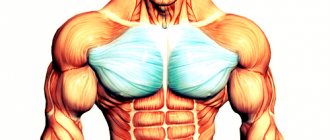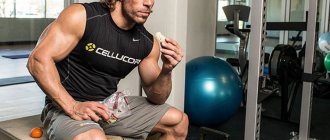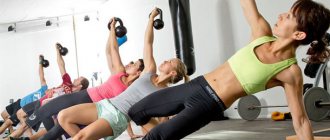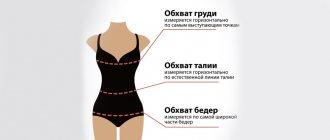Structure
The chest contains movable connections between the ribs and the spine and the ribs and the sternum. The chest skeleton includes three muscle groups. The first group is the superficial muscles, the second group is the deep muscles. The third group is one large muscle - the diaphragm, which separates the chest from the abdominal cavity and is the main respiratory muscle.
https://youtu.be/gVi5d36jPDw
Role
The chest plays a protective role for the organs inside, mainly the heart and lungs. Also takes part in the breathing process. Many problems can appear in the chest area, which can negatively affect the functioning of internal organs, as well as significantly worsen a person’s appearance. Therefore, it is very important that work on the correct construction and proportions of the chest is carried out taking into account the indicators of the whole body. It is important to know the normal chest circumference.
Chest type
In clinical anatomy, the following possible scenarios are distinguished:
- Normosthenic, when the ratio of width and depth is correct, the supra- and subclavian fossae are moderately depressed, the ribs run obliquely, the distance between them remains normal, the shoulder blades are loosely pressed to the chest, and the epigastric angle is straight.
- The asthenic type most often occurs in slender people. The size representing the depth of the chest is smaller, thereby creating the impression that it has an elongated shape. Most often, the pits near the collarbone are sharply expressed, the skin above them sinks. The ribs are arranged vertically rather than at an angle; the angle formed by the xiphoid process is acute. In such people, the muscles of the shoulder and back are most often poorly developed, and the lower edge of the ribs is easily felt during palpation.
- Hypersthenic type, which corresponds to what? The chest is slightly similar to a cylinder, the depth and width are the same, the spaces between the ribs are narrow, they are located almost parallel. The supraclavicular and subclavian fossae are poorly distinguished, the epigastric angle is obtuse.
- occurs in patients with COPD and bronchial asthma. It is similar to hypersthenic, but has fairly wide intercostal spaces, the course of the ribs is horizontal, with virtually no slope, the shoulder blades are located close to the ribs, there is no obvious separation of the supraclavicular and subclavian fossae.
- The paralytic chest is similar in appearance to the asthenic one. It occurs in patients with tuberculosis, chronic diseases of the lungs, pleura, in severely malnourished, cachectic people and in genetic pathology - Morphan syndrome.
- Rachitic, or keeled chest - occurs mainly in children. Its distinctive features are the depression in the central part in the sternum area. And also the presence of a symptom of rosary, thickening at the place of transition of the bony part of the rib into the cartilaginous part due to improper osteogenesis.
Measuring rules
Measurements of chest circumference in children and adults must be performed while standing on level ground. The posture that a person takes during measurement should exclude any tension. This may distort the chest circumference data. The measuring tape should fit perfectly to the body along its entire length. Don't squeeze your chest too hard and bend over.
Before measuring chest circumference, you do not need to draw in more air into your lungs. After all, this significantly increases the chest girth. For a man with a height of 175 cm and a weight of 75 kg, the normal chest circumference is 104.3 cm.
Basic measurements of typical children's figures of preschool age
| Measurement name | Symbols of measurements | Height, cm | ||||||||||
| 74 | 80 | 86 | 92 | 96 | 98 | 104 | 110 | 116 | 122 | 128 | ||
| Neck circumference | OSH | 25 | 25 | 26 | 27 | 27 | 27 | 28 | 28 | 29 | 30 | 30 |
| Bust | OG | 51 | 53 | 55 | 56 | 56,5 | 57 | 58 | 59 | 60 | 62 | 66 |
| Waist circumference | FROM | 48 | 50 | 51 | 52 | 52,5 | 53 | 54 | 55 | 56 | 57 | 60 |
| Hip girth | ABOUT | 52 | 54 | 56 | 58 | 59 | 59 | 61 | 63 | 65 | 67 | 70 |
| Shoulder width | ShP | 6 | 6,5 | 7 | 7 | 7,5 | 8 | 8,5 | 9 | 9,5 | 10 | 10 |
| The length of the sleeve | AP | 23 | 26 | 28 | 31 | 32 | 33 | 36 | 38 | 41 | 43 | 46 |
| Back width | Shs | 18 | 19,5 | 20 | 21 | 22 | 24 | 24,5 | 25 | 25,5 | 26 | 27 |
| Back length to waist line | dst | 19 | 20 | 22 | 23 | 23,5 | 24 | 25 | 26 | 27 | 29 | 30 |
| Front length to waistline | dpt | 18 | 19 | 22 | 23 | 24 | 24,5 | 25 | 25 | 26 | 28 | 29 |
| Upper arm circumference | OR | 16 | 16,5 | 17 | 17,5 | 17,5 | 18 | 18 | 18,5 | 18,5 | 19,5 | 21 |
Measurement of head and chest circumference should be carried out during a routine visit to specialists. It is important to evaluate the shape of these body parts. The data will help assess the state of the child’s development and take the necessary measures in a timely manner.
Very important indicators of child development are anthropometric data of head and chest circumference. Immediately after birth, these parameters are measured. It is important to examine the child’s skeletal system. When examining the head, its shape and size are assessed.
The shape of the chest can also be different and indicate the state of health. Subsequently, the local pediatrician will correlate new indicators with them. Any deviations from the norm are regarded as serious pathological changes in the development of the body. In this case, the doctor prescribes a consultation with other specialists in order not to miss the progression of the disease and to begin appropriate treatment.
Perfect option
Even if a woman loves a man, she probably sometimes compares him with others. I wonder what is missing from it. Scientists have asked themselves what constitutes the ideal chest circumference in men. What does the so-called ideal person look like? We learn this from a survey conducted in the UK.
Based on all available data, a portrait of a typical representative of the sex was created. In particular, average height, weight and several other important body indicators have been established. We can say that a portrait of the average European was drawn up. On this basis, an assessment is made of whether the body is within normal limits.
Research shows that men have changed significantly in their performance over the past few decades. The average chest circumference of a man today is almost 110 cm. And, as a rule, it’s not a matter of large muscles, but an excess of adipose tissue.
Table of typical children's measurements according to Ptenert, Heine
^ Average chest circumference in girls 7-17 years oldAge, years
As follows from the table, chest circumference slowly increases from 59.4 cm at 7 years to 75.2 cm in the year of menstruation. ^ Centile values of chest circumference girls 7-17
At the age of 14 years, the range of values for the majority of schoolgirls was 7 cm (75-82 cm). Reached a maximum at 14 years (6.4 cm), indicating significant individual differences. After 15 years, individual variations in chest circumference decreased and at 17 years old they were equal to 3.1 cm. The compiled centile tables allowed us to assess the degree of harmonious physical development of girls of all studied ages, including taking into account health groups. According to the results of the study, it was revealed that the physical development of girls of 7 and 8 years of age in most cases (79.3% and 82.1%) is harmonious. However, I noticed that approximately every fifth girl (20.7% and 17.9%, respectively) had disharmony in physical development, manifested by a lag in body weight and height. A pronounced asthenic body type was identified in 4.7% of girls aged 7 years and 1.3% of girls aged 8 years. Among schoolgirls aged 9-10 years, the number of harmoniously developed girls increased slightly - to 89.9% and 91.5%, respectively. The identified patterns were observed both in absolutely healthy girls and in girls of health groups 2 and 3. Similar trends in the physical development of girls continued to persist until the age of 12. In 12-13 year old girls, based on the data obtained, an increase in the frequency of disharmony in physical development was again noted. So, for example, at the age of 10, 8.5% of those examined were found to be disharmoniously developed, and at the age of 13, the frequency of their identification was 20.6%. Moreover, during this age period it was not possible to identify the dependence of the degree of harmonious development on the state of general health of girls. The percentage of girls with harmonious development in health groups 1 and 3 was 75 and 73, respectively; the frequency of detection of disharmoniously (20% and 19.2%) and severely disharmoniously (5% and 7.5%) girls was similarly correlated. ^ Correlation of degrees of harmonious physical development of examined girls aged 7-17 years, %
At the age of 14, while maintaining the patterns described above, we registered a significant difference in the indicators of harmony of physical development of girls of different health groups, which had not been identified earlier. In the period from 15 to 17 years, no significant redistribution of the frequency of harmoniously and disharmoniously developed girls was registered. Moreover, in the group of 15-17 year old schoolgirls, it was not possible to identify a clear dependence of the harmonious development on the level of general health. When assessing puberty, carried out in all 2000 girls aged 7-17 years, the main attention was paid to determining the degree of expression of secondary sexual characteristics in the studied age groups, identifying the age of menarche and the formation of the menstrual cycle. In addition, an important indicator of development is the configuration of the bony pelvis. What drew attention was the synchronicity of the increase in all studied pelvic sizes within each age group. As a result of the consistent increase in size, the shape of the vast majority of the bone pelvises of the examined girls corresponded to the female morphotype. We identified 3 main age periods of active increase in pelvic size in the examined girls - at 8-9 years, 10-12 years and at 15-16 years. The most intensive growth is observed in the age range from 10 to 12 years, that is, on the eve of menarche. The intertrochanteric size increased by 3 cm, the intercrestal and interspinous size by 2.4 and 2.5 cm, and the external conjugate by 2.6 cm, which accounted for a third of the total increase in pelvic size from 7 to 17 years. In the next 2 years, a slight slowdown in the growth rate of the pelvic bones was noted, with a predominance of an increase in transverse dimensions (0.9-1.1 cm) over the external conjugate (0.5 cm). By the age of 17, the overall increase in intertrochanteric size was 8.3, intercrestal - 7.5, interspinous - 7.0 and external conjugate - 6.4 cm. ^ Indicators of pelvic size in girls 7-17 years old
The following tables present centile distributions of external pelvic dimensions in girls for the age period under study.
^ Centile values of the intercrestal size of the pelvis in girls 7-17
^ Centile values of intertrochanteric pelvic size in girls
^ Centile values of the external pelvic conjugate in girls
Centile assessment of the size of the pelvis, taking into account age, made it possible to more fully characterize the harmonious development of not only the bony pelvis, but also the general physical development of schoolgirls in Nalchik. | ||||||||||||||||||||||||||||||||||||||||||||||||||||||||||||||||||||||||||||||||||||||||||||||||||||||||||||||||||||||||||||||||||||||||||||||||||||||||||||||||||||||||||||||||||||||||||||||||||||||||||||||||||||||||||||||||||||||||||||||||||||||||||||||||||||||||||||||||||||||||||||||||||||||||||||||||||||||||||||||||||||||||||||||||||||||||||||||||||||||||||||||||||||||||||||||||||||||||||||||||||||||||||||||||||||||||||||||||||||||||||||||||||||||||||||||||||||||||||||||||||||||||||||||||||||||||||||||||||||||||||||||||||||||||||||||||||||||||||||||||||||||||||||||||||||||||||||||||||||||||||||||||||||||||||||||||||||||||||||||||
| Age | Head circumference | Chest circumference | Age | Head circumference | Chest circumference | |||||||||||||||||||||||||||||||||||||||||||||||||||||||||||||||||||||||||||||||||||||||||||||||||||||||||||||||||||||||||||||||||||||||||||||||||||||||||||||||||||||||||||||||||||||||||||||||||||||||||||||||||||||||||||||||||||||||||||||||||||||||||||||||||||||||||||||||||||||||||||||||||||||||||||||||||||||||||||||||||||||||||||||||||||||||||||||||||||||||||||||||||||||||||||||||||||||||||||||||||||||||||||||||||||||||||||||||||||||||||||||||||||||||||||||||||||||||||||||||||||||||||||||||||||||||||||||||||||||||||||||||||||||||||||||||||||||||||||||||||||||||||||||||||||||||||||||||||||||||||||||||||||||||||||||||||||||||||||
| cm | % body length | cm | % body length | cm | % body length | cm | % body length | |||||||||||||||||||||||||||||||||||||||||||||||||||||||||||||||||||||||||||||||||||||||||||||||||||||||||||||||||||||||||||||||||||||||||||||||||||||||||||||||||||||||||||||||||||||||||||||||||||||||||||||||||||||||||||||||||||||||||||||||||||||||||||||||||||||||||||||||||||||||||||||||||||||||||||||||||||||||||||||||||||||||||||||||||||||||||||||||||||||||||||||||||||||||||||||||||||||||||||||||||||||||||||||||||||||||||||||||||||||||||||||||||||||||||||||||||||||||||||||||||||||||||||||||||||||||||||||||||||||||||||||||||||||||||||||||||||||||||||||||||||||||||||||||||||||||||||||||||||||||||||||||||||||||||||||||||||||||||
| Boys | Girls | |||||||||||||||||||||||||||||||||||||||||||||||||||||||||||||||||||||||||||||||||||||||||||||||||||||||||||||||||||||||||||||||||||||||||||||||||||||||||||||||||||||||||||||||||||||||||||||||||||||||||||||||||||||||||||||||||||||||||||||||||||||||||||||||||||||||||||||||||||||||||||||||||||||||||||||||||||||||||||||||||||||||||||||||||||||||||||||||||||||||||||||||||||||||||||||||||||||||||||||||||||||||||||||||||||||||||||||||||||||||||||||||||||||||||||||||||||||||||||||||||||||||||||||||||||||||||||||||||||||||||||||||||||||||||||||||||||||||||||||||||||||||||||||||||||||||||||||||||||||||||||||||||||||||||||||||||||||||||||||||
| Up to 1 month | 35 | 69 | 34 | 67 | Up to 1 month | 34 | 68 | 33 | 66 | |||||||||||||||||||||||||||||||||||||||||||||||||||||||||||||||||||||||||||||||||||||||||||||||||||||||||||||||||||||||||||||||||||||||||||||||||||||||||||||||||||||||||||||||||||||||||||||||||||||||||||||||||||||||||||||||||||||||||||||||||||||||||||||||||||||||||||||||||||||||||||||||||||||||||||||||||||||||||||||||||||||||||||||||||||||||||||||||||||||||||||||||||||||||||||||||||||||||||||||||||||||||||||||||||||||||||||||||||||||||||||||||||||||||||||||||||||||||||||||||||||||||||||||||||||||||||||||||||||||||||||||||||||||||||||||||||||||||||||||||||||||||||||||||||||||||||||||||||||||||||||||||||||||||||||||||||||||||
| 1 month | 37 | 69 | 36 | 67 | 1 month | 36 | 68 | 35 | 66 | |||||||||||||||||||||||||||||||||||||||||||||||||||||||||||||||||||||||||||||||||||||||||||||||||||||||||||||||||||||||||||||||||||||||||||||||||||||||||||||||||||||||||||||||||||||||||||||||||||||||||||||||||||||||||||||||||||||||||||||||||||||||||||||||||||||||||||||||||||||||||||||||||||||||||||||||||||||||||||||||||||||||||||||||||||||||||||||||||||||||||||||||||||||||||||||||||||||||||||||||||||||||||||||||||||||||||||||||||||||||||||||||||||||||||||||||||||||||||||||||||||||||||||||||||||||||||||||||||||||||||||||||||||||||||||||||||||||||||||||||||||||||||||||||||||||||||||||||||||||||||||||||||||||||||||||||||||||||
| 2 months | 39 | 68 | 38 | 66 | 2 months | 38 | 68 | 37 | 66 | |||||||||||||||||||||||||||||||||||||||||||||||||||||||||||||||||||||||||||||||||||||||||||||||||||||||||||||||||||||||||||||||||||||||||||||||||||||||||||||||||||||||||||||||||||||||||||||||||||||||||||||||||||||||||||||||||||||||||||||||||||||||||||||||||||||||||||||||||||||||||||||||||||||||||||||||||||||||||||||||||||||||||||||||||||||||||||||||||||||||||||||||||||||||||||||||||||||||||||||||||||||||||||||||||||||||||||||||||||||||||||||||||||||||||||||||||||||||||||||||||||||||||||||||||||||||||||||||||||||||||||||||||||||||||||||||||||||||||||||||||||||||||||||||||||||||||||||||||||||||||||||||||||||||||||||||||||||||
| 3 months | 41 | 67 | 39 | 64 | 3 months | 40 | 68 | 38 | 64 | |||||||||||||||||||||||||||||||||||||||||||||||||||||||||||||||||||||||||||||||||||||||||||||||||||||||||||||||||||||||||||||||||||||||||||||||||||||||||||||||||||||||||||||||||||||||||||||||||||||||||||||||||||||||||||||||||||||||||||||||||||||||||||||||||||||||||||||||||||||||||||||||||||||||||||||||||||||||||||||||||||||||||||||||||||||||||||||||||||||||||||||||||||||||||||||||||||||||||||||||||||||||||||||||||||||||||||||||||||||||||||||||||||||||||||||||||||||||||||||||||||||||||||||||||||||||||||||||||||||||||||||||||||||||||||||||||||||||||||||||||||||||||||||||||||||||||||||||||||||||||||||||||||||||||||||||||||||||
| 6 months | 44 | 65 | 43 | 63 | 6 months | 43 | 65 | 42 | 64 | |||||||||||||||||||||||||||||||||||||||||||||||||||||||||||||||||||||||||||||||||||||||||||||||||||||||||||||||||||||||||||||||||||||||||||||||||||||||||||||||||||||||||||||||||||||||||||||||||||||||||||||||||||||||||||||||||||||||||||||||||||||||||||||||||||||||||||||||||||||||||||||||||||||||||||||||||||||||||||||||||||||||||||||||||||||||||||||||||||||||||||||||||||||||||||||||||||||||||||||||||||||||||||||||||||||||||||||||||||||||||||||||||||||||||||||||||||||||||||||||||||||||||||||||||||||||||||||||||||||||||||||||||||||||||||||||||||||||||||||||||||||||||||||||||||||||||||||||||||||||||||||||||||||||||||||||||||||||
| 9 months | 46 | 64 | 45 | 63 | 9 months | 45 | 64 | 44 | 63 | |||||||||||||||||||||||||||||||||||||||||||||||||||||||||||||||||||||||||||||||||||||||||||||||||||||||||||||||||||||||||||||||||||||||||||||||||||||||||||||||||||||||||||||||||||||||||||||||||||||||||||||||||||||||||||||||||||||||||||||||||||||||||||||||||||||||||||||||||||||||||||||||||||||||||||||||||||||||||||||||||||||||||||||||||||||||||||||||||||||||||||||||||||||||||||||||||||||||||||||||||||||||||||||||||||||||||||||||||||||||||||||||||||||||||||||||||||||||||||||||||||||||||||||||||||||||||||||||||||||||||||||||||||||||||||||||||||||||||||||||||||||||||||||||||||||||||||||||||||||||||||||||||||||||||||||||||||||||
| 1 year | 47 | 63 | 47 | 63 | 1 year | 46 | 62 | 47 | 63 | |||||||||||||||||||||||||||||||||||||||||||||||||||||||||||||||||||||||||||||||||||||||||||||||||||||||||||||||||||||||||||||||||||||||||||||||||||||||||||||||||||||||||||||||||||||||||||||||||||||||||||||||||||||||||||||||||||||||||||||||||||||||||||||||||||||||||||||||||||||||||||||||||||||||||||||||||||||||||||||||||||||||||||||||||||||||||||||||||||||||||||||||||||||||||||||||||||||||||||||||||||||||||||||||||||||||||||||||||||||||||||||||||||||||||||||||||||||||||||||||||||||||||||||||||||||||||||||||||||||||||||||||||||||||||||||||||||||||||||||||||||||||||||||||||||||||||||||||||||||||||||||||||||||||||||||||||||||||
| 2 years | 49 | 57 | 51 | 59 | 2 years | 48 | 56 | 50 | 58 | |||||||||||||||||||||||||||||||||||||||||||||||||||||||||||||||||||||||||||||||||||||||||||||||||||||||||||||||||||||||||||||||||||||||||||||||||||||||||||||||||||||||||||||||||||||||||||||||||||||||||||||||||||||||||||||||||||||||||||||||||||||||||||||||||||||||||||||||||||||||||||||||||||||||||||||||||||||||||||||||||||||||||||||||||||||||||||||||||||||||||||||||||||||||||||||||||||||||||||||||||||||||||||||||||||||||||||||||||||||||||||||||||||||||||||||||||||||||||||||||||||||||||||||||||||||||||||||||||||||||||||||||||||||||||||||||||||||||||||||||||||||||||||||||||||||||||||||||||||||||||||||||||||||||||||||||||||||||
| 3 years | 50 | 52 | 52 | 54 | 3 years | 49 | 52 | 51 | 54 | |||||||||||||||||||||||||||||||||||||||||||||||||||||||||||||||||||||||||||||||||||||||||||||||||||||||||||||||||||||||||||||||||||||||||||||||||||||||||||||||||||||||||||||||||||||||||||||||||||||||||||||||||||||||||||||||||||||||||||||||||||||||||||||||||||||||||||||||||||||||||||||||||||||||||||||||||||||||||||||||||||||||||||||||||||||||||||||||||||||||||||||||||||||||||||||||||||||||||||||||||||||||||||||||||||||||||||||||||||||||||||||||||||||||||||||||||||||||||||||||||||||||||||||||||||||||||||||||||||||||||||||||||||||||||||||||||||||||||||||||||||||||||||||||||||||||||||||||||||||||||||||||||||||||||||||||||||||||
| 4 years | 51 | 50 | 53 | 51 | 4 years | 50 | 50 | 52 | 51 | |||||||||||||||||||||||||||||||||||||||||||||||||||||||||||||||||||||||||||||||||||||||||||||||||||||||||||||||||||||||||||||||||||||||||||||||||||||||||||||||||||||||||||||||||||||||||||||||||||||||||||||||||||||||||||||||||||||||||||||||||||||||||||||||||||||||||||||||||||||||||||||||||||||||||||||||||||||||||||||||||||||||||||||||||||||||||||||||||||||||||||||||||||||||||||||||||||||||||||||||||||||||||||||||||||||||||||||||||||||||||||||||||||||||||||||||||||||||||||||||||||||||||||||||||||||||||||||||||||||||||||||||||||||||||||||||||||||||||||||||||||||||||||||||||||||||||||||||||||||||||||||||||||||||||||||||||||||||
| 5 years | 51 | 47 | 55 | 50 | 5 years | 50 | 47 | 53 | 49 | |||||||||||||||||||||||||||||||||||||||||||||||||||||||||||||||||||||||||||||||||||||||||||||||||||||||||||||||||||||||||||||||||||||||||||||||||||||||||||||||||||||||||||||||||||||||||||||||||||||||||||||||||||||||||||||||||||||||||||||||||||||||||||||||||||||||||||||||||||||||||||||||||||||||||||||||||||||||||||||||||||||||||||||||||||||||||||||||||||||||||||||||||||||||||||||||||||||||||||||||||||||||||||||||||||||||||||||||||||||||||||||||||||||||||||||||||||||||||||||||||||||||||||||||||||||||||||||||||||||||||||||||||||||||||||||||||||||||||||||||||||||||||||||||||||||||||||||||||||||||||||||||||||||||||||||||||||||||
| 6 years | 51 | 45 | 57 | 49 | 6 years | 50 | 44 | 55 | 48 | |||||||||||||||||||||||||||||||||||||||||||||||||||||||||||||||||||||||||||||||||||||||||||||||||||||||||||||||||||||||||||||||||||||||||||||||||||||||||||||||||||||||||||||||||||||||||||||||||||||||||||||||||||||||||||||||||||||||||||||||||||||||||||||||||||||||||||||||||||||||||||||||||||||||||||||||||||||||||||||||||||||||||||||||||||||||||||||||||||||||||||||||||||||||||||||||||||||||||||||||||||||||||||||||||||||||||||||||||||||||||||||||||||||||||||||||||||||||||||||||||||||||||||||||||||||||||||||||||||||||||||||||||||||||||||||||||||||||||||||||||||||||||||||||||||||||||||||||||||||||||||||||||||||||||||||||||||||||
| 7 years | 52 | 43 | 58 | 48 | 7 years | 51 | 43 | 57 | 48 | |||||||||||||||||||||||||||||||||||||||||||||||||||||||||||||||||||||||||||||||||||||||||||||||||||||||||||||||||||||||||||||||||||||||||||||||||||||||||||||||||||||||||||||||||||||||||||||||||||||||||||||||||||||||||||||||||||||||||||||||||||||||||||||||||||||||||||||||||||||||||||||||||||||||||||||||||||||||||||||||||||||||||||||||||||||||||||||||||||||||||||||||||||||||||||||||||||||||||||||||||||||||||||||||||||||||||||||||||||||||||||||||||||||||||||||||||||||||||||||||||||||||||||||||||||||||||||||||||||||||||||||||||||||||||||||||||||||||||||||||||||||||||||||||||||||||||||||||||||||||||||||||||||||||||||||||||||||||
| 8 years | 52 | 41 | 59 | 47 | 8 years | 51 | 41 | 59 | 47 | |||||||||||||||||||||||||||||||||||||||||||||||||||||||||||||||||||||||||||||||||||||||||||||||||||||||||||||||||||||||||||||||||||||||||||||||||||||||||||||||||||||||||||||||||||||||||||||||||||||||||||||||||||||||||||||||||||||||||||||||||||||||||||||||||||||||||||||||||||||||||||||||||||||||||||||||||||||||||||||||||||||||||||||||||||||||||||||||||||||||||||||||||||||||||||||||||||||||||||||||||||||||||||||||||||||||||||||||||||||||||||||||||||||||||||||||||||||||||||||||||||||||||||||||||||||||||||||||||||||||||||||||||||||||||||||||||||||||||||||||||||||||||||||||||||||||||||||||||||||||||||||||||||||||||||||||||||||||
| 9 years | 52 | 40 | 61 | 47 | 9 years | 61 | 39 | 61 | 47 | |||||||||||||||||||||||||||||||||||||||||||||||||||||||||||||||||||||||||||||||||||||||||||||||||||||||||||||||||||||||||||||||||||||||||||||||||||||||||||||||||||||||||||||||||||||||||||||||||||||||||||||||||||||||||||||||||||||||||||||||||||||||||||||||||||||||||||||||||||||||||||||||||||||||||||||||||||||||||||||||||||||||||||||||||||||||||||||||||||||||||||||||||||||||||||||||||||||||||||||||||||||||||||||||||||||||||||||||||||||||||||||||||||||||||||||||||||||||||||||||||||||||||||||||||||||||||||||||||||||||||||||||||||||||||||||||||||||||||||||||||||||||||||||||||||||||||||||||||||||||||||||||||||||||||||||||||||||||
| 10 years | 52 | 38 | 64 | 47 | 10 years | 51 | 38 | 63 | 48 | |||||||||||||||||||||||||||||||||||||||||||||||||||||||||||||||||||||||||||||||||||||||||||||||||||||||||||||||||||||||||||||||||||||||||||||||||||||||||||||||||||||||||||||||||||||||||||||||||||||||||||||||||||||||||||||||||||||||||||||||||||||||||||||||||||||||||||||||||||||||||||||||||||||||||||||||||||||||||||||||||||||||||||||||||||||||||||||||||||||||||||||||||||||||||||||||||||||||||||||||||||||||||||||||||||||||||||||||||||||||||||||||||||||||||||||||||||||||||||||||||||||||||||||||||||||||||||||||||||||||||||||||||||||||||||||||||||||||||||||||||||||||||||||||||||||||||||||||||||||||||||||||||||||||||||||||||||||||
| 11 years | 53 | 38 | 66 | 46 | 11 years | 52 | 37 | 66 | 48 | |||||||||||||||||||||||||||||||||||||||||||||||||||||||||||||||||||||||||||||||||||||||||||||||||||||||||||||||||||||||||||||||||||||||||||||||||||||||||||||||||||||||||||||||||||||||||||||||||||||||||||||||||||||||||||||||||||||||||||||||||||||||||||||||||||||||||||||||||||||||||||||||||||||||||||||||||||||||||||||||||||||||||||||||||||||||||||||||||||||||||||||||||||||||||||||||||||||||||||||||||||||||||||||||||||||||||||||||||||||||||||||||||||||||||||||||||||||||||||||||||||||||||||||||||||||||||||||||||||||||||||||||||||||||||||||||||||||||||||||||||||||||||||||||||||||||||||||||||||||||||||||||||||||||||||||||||||||||
| 12 years | 53 | 37 | 68 | 47 | 12 years | 52 | 36 | 71 | 49 | |||||||||||||||||||||||||||||||||||||||||||||||||||||||||||||||||||||||||||||||||||||||||||||||||||||||||||||||||||||||||||||||||||||||||||||||||||||||||||||||||||||||||||||||||||||||||||||||||||||||||||||||||||||||||||||||||||||||||||||||||||||||||||||||||||||||||||||||||||||||||||||||||||||||||||||||||||||||||||||||||||||||||||||||||||||||||||||||||||||||||||||||||||||||||||||||||||||||||||||||||||||||||||||||||||||||||||||||||||||||||||||||||||||||||||||||||||||||||||||||||||||||||||||||||||||||||||||||||||||||||||||||||||||||||||||||||||||||||||||||||||||||||||||||||||||||||||||||||||||||||||||||||||||||||||||||||||||||
| 13 years | 53 | 36 | 71 | 48 | 13 years | 53 | 35 | 74 | 49 | |||||||||||||||||||||||||||||||||||||||||||||||||||||||||||||||||||||||||||||||||||||||||||||||||||||||||||||||||||||||||||||||||||||||||||||||||||||||||||||||||||||||||||||||||||||||||||||||||||||||||||||||||||||||||||||||||||||||||||||||||||||||||||||||||||||||||||||||||||||||||||||||||||||||||||||||||||||||||||||||||||||||||||||||||||||||||||||||||||||||||||||||||||||||||||||||||||||||||||||||||||||||||||||||||||||||||||||||||||||||||||||||||||||||||||||||||||||||||||||||||||||||||||||||||||||||||||||||||||||||||||||||||||||||||||||||||||||||||||||||||||||||||||||||||||||||||||||||||||||||||||||||||||||||||||||||||||||||
| 14 years | 54 | 35 | 74 | 48 | 14 years | 53 | 34 | 76 | 49 | |||||||||||||||||||||||||||||||||||||||||||||||||||||||||||||||||||||||||||||||||||||||||||||||||||||||||||||||||||||||||||||||||||||||||||||||||||||||||||||||||||||||||||||||||||||||||||||||||||||||||||||||||||||||||||||||||||||||||||||||||||||||||||||||||||||||||||||||||||||||||||||||||||||||||||||||||||||||||||||||||||||||||||||||||||||||||||||||||||||||||||||||||||||||||||||||||||||||||||||||||||||||||||||||||||||||||||||||||||||||||||||||||||||||||||||||||||||||||||||||||||||||||||||||||||||||||||||||||||||||||||||||||||||||||||||||||||||||||||||||||||||||||||||||||||||||||||||||||||||||||||||||||||||||||||||||||||||||
| Adult | 56 | 32 | 87 | 50 | Adult | 55 | 33 | 82 | 50 | |||||||||||||||||||||||||||||||||||||||||||||||||||||||||||||||||||||||||||||||||||||||||||||||||||||||||||||||||||||||||||||||||||||||||||||||||||||||||||||||||||||||||||||||||||||||||||||||||||||||||||||||||||||||||||||||||||||||||||||||||||||||||||||||||||||||||||||||||||||||||||||||||||||||||||||||||||||||||||||||||||||||||||||||||||||||||||||||||||||||||||||||||||||||||||||||||||||||||||||||||||||||||||||||||||||||||||||||||||||||||||||||||||||||||||||||||||||||||||||||||||||||||||||||||||||||||||||||||||||||||||||||||||||||||||||||||||||||||||||||||||||||||||||||||||||||||||||||||||||||||||||||||||||||||||||||||||||||
Children's size chart
, or rather, standard measurements that you need to know if you are going to sew or buy clothes for your child. By determining your baby's height using the table, you will see what the child's waist or chest circumference should be. Of course, the table provides information for standard figures, individual deviations from the standard, I think mothers will determine for themselves.
Mass and circumference
It is noteworthy that measuring the volume of the hips and chest can provide more reliable information about progress in training than daily weighings. This happens because muscle mass, which increases with exercise, weighs more than fat tissue. There are many beneficial changes that can occur in the body that the measurement of kilograms will not confirm. To notice them, it is advisable to regularly measure separately the shoulders, chest, biceps, chest, waist (belt), and hips. The results obtained should be recorded and then compared - the table created in this way will be the best evidence of the development of the body.
Additional recommendations
Measure yourself in your underwear, not in clothes (even tight ones). You need to start with the upper parts of the body (in order: shoulders, biceps, chest, waist, hips). Take measurements in the morning, before breakfast, preferably always at the same time. And thus the results will be reliable.
Here is a handy hint on how to correctly measure the circumference of your shoulders, chest, waist (measurements are done in the same way for men and women), and hips. Use a measuring tape to measure. Every two weeks you need to save your results in a table, and you will see how beneficial strength training affects your figure.
To make measurements as reliable as possible, remember a few rules:
- always ask the same person to take measurements;
- while taking measurements you need to stand naturally;
- during measurements, you need to place your legs at a small and always the same distance: to make the distance identical, place a ruler between your legs;
- when measuring, the centimeter should not dig into the skin or fit too loosely on the body;
- take three measurements of a specific body segment and calculate the average value from the results obtained;
- All measurements, with the exception of the biceps, are carried out with the tape taken horizontally: you need to make sure that the meter is at the same level in front, back and sides;
- always use the same instrument to measure body parameters;
- You should not compare measurements made using different instruments.
Determination of lung volume
To evaluate the obtained indicators, use the Ludwig formula:
- Calculation for men: vital capacity = 40*height (cm)+30*weight (kg) -4400;
- Calculation for women: vital capacity = 40*height (cm)+10*weight (kg) -3800.
For the formula, you can use the indicators from the table:
| Weight, kg | Height, cm | ||||
| 160 | 170 | 180 | 190 | 200 | |
| 50 | 3000 | 3300 | 3600 | 3900 | 4200 |
| 60 | 3300 | 3600 | 3900 | 4200 | 4500 |
| 70 | 3600 | 3900 | 4200 | 4500 | 4800 |
| 80 | 3900 | 4200 | 4500 | 4800 | 5100 |
| 90 | 4200 | 4500 | 4800 | 5100 | 4400 |
| 100 | 4500 | 4800 | 5100 | 5400 | 5800 |
With age, deviations occur towards a decrease in lung volume, including due to a decrease in the level of activity compared to young people.
Weight, height and girth
Almost everyone, without exception, prefers tall height in men. It is often stated that 180 cm is the minimum. The bigger, the better. Meanwhile, the average height for a European is only (or maybe for now?) 177.8 cm. Theoretically, this is not the worst result, but given the ever-increasing height of a woman, it is difficult to admire this.
It doesn't take an expert to spot the obvious trend. From year to year, men gain weight. Already today the average is 83.5 kg. Of course, it all depends on height, proportions and the ratio of fat tissue to muscle tissue, but the average person is most likely not a bodybuilder. One might even conclude that the average man would do well to take steps to lose weight.
These trends have a direct impact on changes in chest circumference assessment. What used to be the average chest circumference is no longer so. Therefore, you should not use outdated data.
The times we live in have created their own idea of the ideal male silhouette. The ideal male body can be described using three adjectives: muscular, proportional, tall. And chest circumference plays a big role in this. Ideally, it should be at least 100 cm. It should always be greater than the circumference of the hips. This value is changeable; a person can influence it when playing sports. And at different periods of life the value changes.










